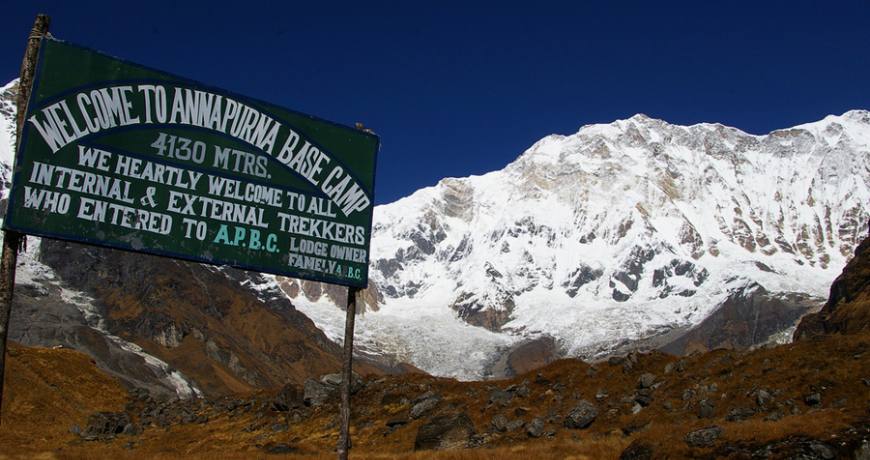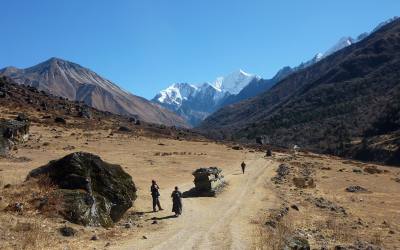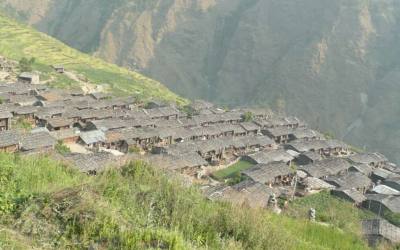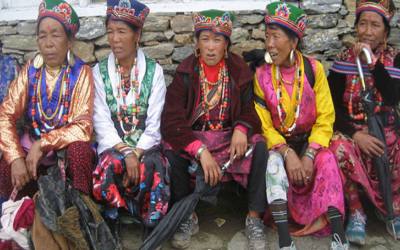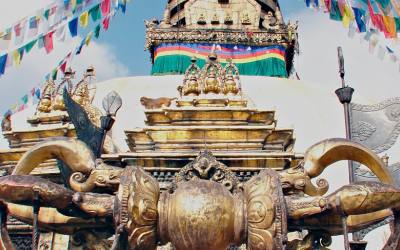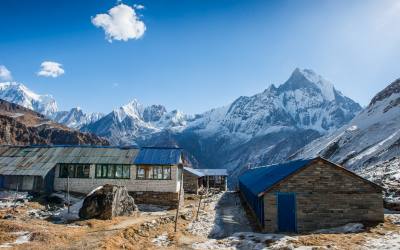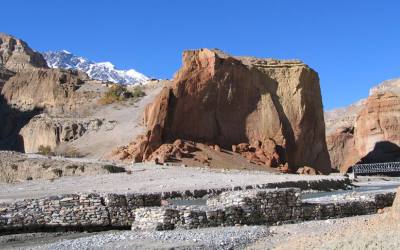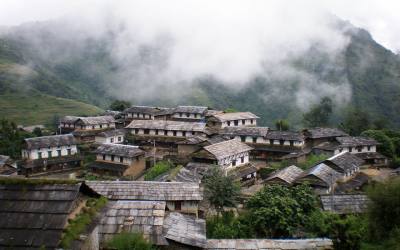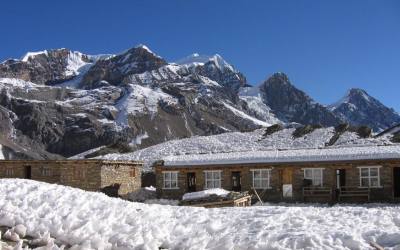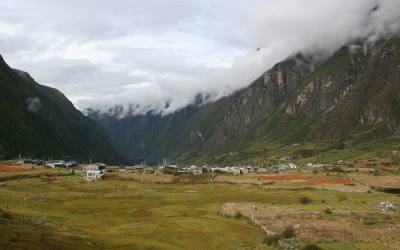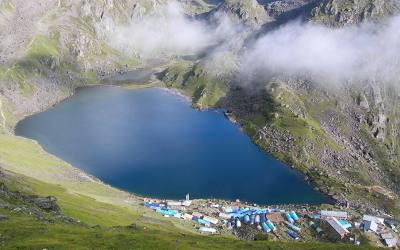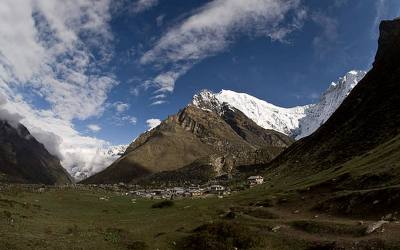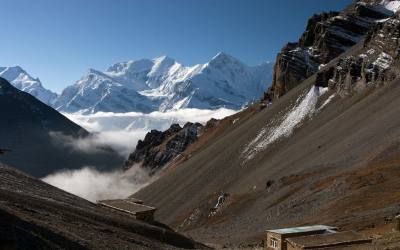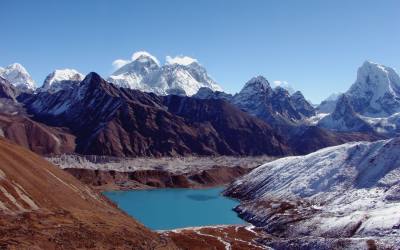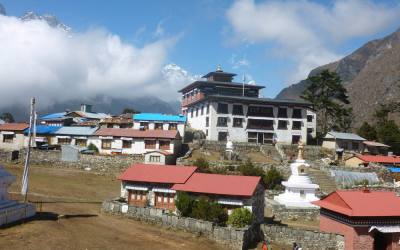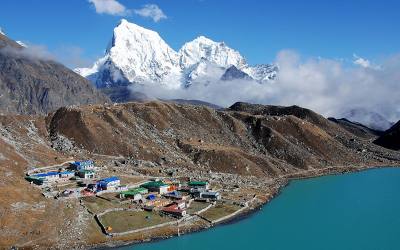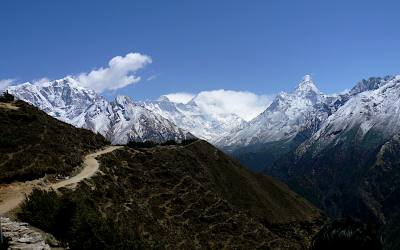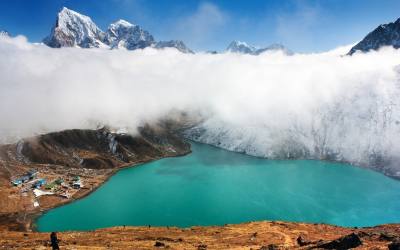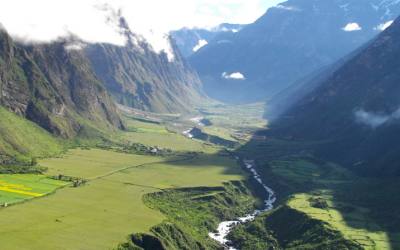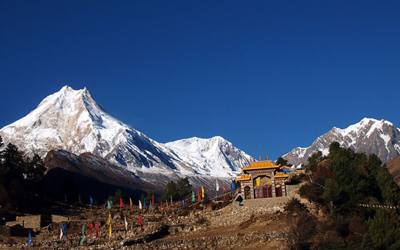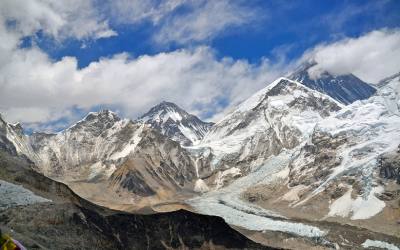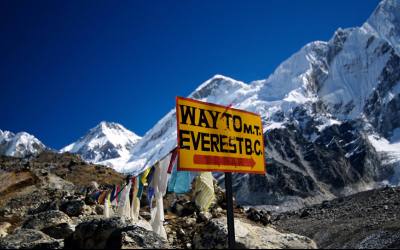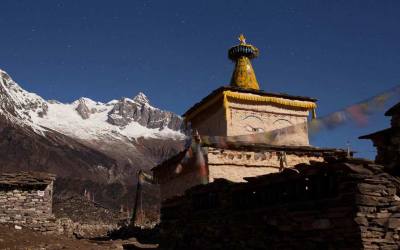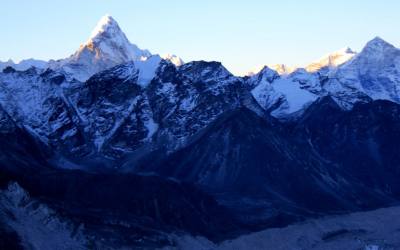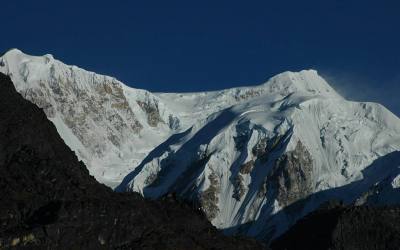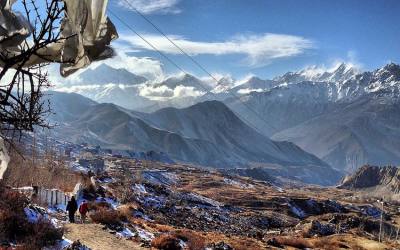Trek to Annapurna Sanctuary (Base camp)
Beside the Everest region, the area around the Annapurna massif is perhaps the best known trekking destination in Nepal. Based on sheer numbers of trekking visitors it is certainly the most popular. As the title suggests, the centre piece of this part of Nepal is the range of mountains that includes Annapurna I, the first of the 8000 meter peaks to be climbed. Also included in this general area is another 8000 meter giant, Dhaulagiri , which is located west of Annapurna I. Between these two mountains runs the valley of the Kali-Gandaki River, the deepest gorge on earth. Combine this with lush, fertile farming land, stands of undistributed natural forest and a mixture of different ethnic inhabitants and you have a diverse range of experiences that makes this area one of the most satisfying trekking destinations in Nepal.
The fact that the main Himalayan range runs south of the border with Tibet means that that the northern parts of the area are in the rain shadow and are considerably drier than the southern slopes of the mountains. This leads to unusually diverse landscapes.
Flora and Fauna
As can be imagined, the range of geographical and climatic regions has led to a diverse variety of flora and fauna within the Annapurna region. Both Pokhara and Besishahar are below 1000 meter elevation and their climate is quiet tropical. These parts of area are heavily cultivated and the landscape, therefore, largely consists of terraced paddy fields for most of the year. The area is also famous for its winter crops of oranges, which can be purchased fresh from the trees along the trails in the foothills. As you progress higher up into the hills the natural vegetation changes from the tropical species to more temperate stands of forest trees including oak, beech and rhododendron. These finally give way to coniferous forests of pine and, ultimately, juniper just below the tree line. In the rain shadow, to the north of the mountains, the landscape is quite barren being an extension south of the Tibetan plateau. Here there are only stunted bushes and shrubs except for close to the rivers where irrigated cropping is possible.
Native animals to be seen include many birds the most obvious being the pika, blue sheep and Himalayan Tahr.
Trekking styles
Most of the trekking routes in the Annapurna region are well serviced by teahouses for most of their length. This is particularly true for most popular treks-the Jomsom trek, the Annapurna circuit and Annapurna base camp treks.
Trekkers should be aware, however that there is always the risk of being stranded by bad weather or injury/sickness between teahouses, particularly in the more remote parts of the trek itineraries. a good example is on the Annapurna circuit where there is one very long day when the high pass of Thorong La has to be crossed. There is little or no shelter available for most of this day and some trekkers have been caught unprepared by bad weather and altitude problems.
The treks in less developed areas, particularly the Dhaulagiri circuit and the trek east of Lamjung, definitely require trekkers to be self sufficient in food and shelter.
People and Culture
The most prominent ethnic groups in the Annapurna region are the Gurung, the Thakali and the Manangba. The Gurungs are the most widely distributed being found from the hills of Gorkha district to as far west as Palpa. There heartland, however, is centered on the hills and valleys between the Marsyandi river and the kali Gandaki. The Thakali come from the upper kali Gandaki valley around Jomsom where their traditional farming has being supplemented by trade and, in particular, hotel and restaurant businesses. The Manangba are found in the upper reaches of the Marsyandi River and are in many ways similar to the Gurungs to whom they are possibly related. They are skilled traders and trace their roots back to Tibet. Religiously, the Manangba and the Gurungs of the upper hills is Buddhist with traces of their ancient, shamanistic faith still apparent. The communities live further south are predominantly Hindu.
All of the communities, particularly the Gurungs are famed for their cultural performances, which are easily seen while trekking in the region. Many villages along the trails will arrange performances for trekkers during the main seasons.
When to visit?
As with most of the trekking areas in Nepal, the best time to visit are during spring and autumn. Spring is the time for rhododendrons while the clearest skies are found after the monsoon in October and November. At these times the weather is generally mild and there is little rainfall. Unlike other parts of Nepal, the monsoon, from June to September, is the ideal time to visit pats of the region that falls in the rain shadow. In particular, upper mustang is the perfect destination during the rainy season. The winter months provide good trekking conditions throughout the foothills but some of the higher passes will be closed due to snow.
The other classic trek in the Annapurna region is to the so called Annapurna sanctuary, the site of the base camp used by expeditions attempting the massive south face of Annapurna I. a short trek, it can be completed in as little as eight days from Pokhara. The trek to Annapurna base camp combines some of the most spectacular mountain scenery with a fascinating insight into the life of middle hill Nepalis. The best time to visit the sanctuary is during the main trekking season of spring and autumn but since the route is not a circuit, the trial, and the teahouses, can become crowded at these times. Winter trek are possible but at any time trekkers must beware of snowfall and avalanches that can block the narrow entrance to the sanctuary.
This trek is usually started and ended in Pokhara but it can also be made a part of the Annapurna circuit or the Jomsom trek by trekking from Tatopani through Ghorepani and Tadapani and joining the main sanctuary trial at Chomrong. For maximum enjoyment, allow twelve or fourteen days for the trek, which allows time for exploration inside the sanctuary and also the chance to extend the route on to Ghorepani and Poon hill. Trekkers traveling this route must obtain an ACAP entry permit either from Kathmandu or Pokhara before commencing the trek.
To start the trek at Pokhara there are a number of choices of route. Perhaps the best is to take a taxi or bus to Naudanda Phedi where the trial up to Dhampus will be found. The route passes through a number of Gurung settlements including Dhampus, Pothana and Landrung. At Landrung the choice is to cross to Ghandrung, a descent and subsequent climb involving several hundred meters of elevation change, or to continue on up the Modi khola through Naya Pul. Both trials join at Chomrong at the foot of the gorge leading to the sanctuary. An additional attraction on the Naya Pul trial is a very welcome hot spring half way to Chomrong.
From Chomrong there is only one trial, which follows the ever-narrowing most khola to finally enter the sanctuary. Due to the altitude gain, two nights must be spent between Chomrong and the sanctuary in order to avoid the risk of AMS. There are a number of settlements in the valley, providing ample accommodation. However, during winter it is wide to check at Chomrong in case the teahouse up the valley has closed for the off season.
The trial up the Modi khola passes through dense stands of rhododendron and bamboo for the first day. By the time the large rock overhang, known as Hinku cave, is reached the vegetation has thinned and the gorge narrowed to be only a few hundred meters wide. Steep, snow-clad ridges falling from Himchuli on the left and Machhapuchhre on the right from the entrance to the sanctuary. as you pass through the gate and enter the sanctuary you will find yourself in a huge amphitheater enclosed by a solid wall of snow capped peaks which include Annapurna I, II, III and IV plus the fish tailed spire of the Machhapuchhre. Teahouses are available at Machhapuchhre base camp, just inside the sanctuary, or at Annapurna base camp, a further two hours beyond.
Spend at least one full day inside the sanctuary. Side trips across the south Annapurna glacier, north from Annapurna base camp allow for an even better appreciation of this unique place.
Day01: Arrival and transfer to hotel in kathmandu.
Day02: Free day in Kathmandu or self sight seeing around kathmandu valley
Day03: By Regular tourist bus to Pokhara then by private transport to Nyapul.trek for 20 minute to Birethanty ( 1000m) over night at lodge
Day04: Trek to Banthanty (2300m) 6-7 hrs of trek
Day05: Trek to Ghorepani ( 2850m) 5-hrs of trek
Day06: Sunrise tour to Poon hill ( 3210m) then trek to Tadapani ( 2650m) 6-7 hrs of trek
Day07: Trek to Chomorong ( 2000m) 6-7 hrs of trek
Day08: Trek to Doban or to Deurali( 3300m) 6-7 hrs of trek
Day09: Trek to Annapurna base camp ( 4100m) 6-7 hrs of trek
Day10: Trek to Bamboo ( 2500m) 6-7 hrs of trek
Day11: Trek to Jhinu Danda ( Hot spring 1750m) 6 hrs of trek
Day12: Trek to Birethanty then by private transport to Pokhara 5-6 hrs of trek.
Day13: Free day in pokhara or self sight seeing around
Day14: Return back to Kathmandu by tourist bus. The bus journey will take 7 to 8 hrs. or by air it takes 40 minutes. if you come back with early flight than at the afternoon self visiting to Bhaktapur city
Day15: Tour Ends ( Departure)
Day 01: Arrival and transfer to hotel in Kathmandu
Upon arrival in Kathmandu. Our airport representative will be waiting outside the airport terminal a few metres from the exit door. Please check your name at play card. He will bring you to hotel in kathmandu. The drive from the airport to the hotel is around 20 minutes.
Day 02:Free day in Kathmandu or self sight seeing around valley (option are)
Mount Everest flight
It is possible to book a flight to see Mount Everest whilst you are in Kathmandu. The cost is US$190.00 (subject to change) per person .
The one hour Everest flight takes off from Kathmandu Airport and flies east where you can see magnificent mountains, including Mount Everest, from a height of around 25,000 feet. You can enjoy a seemingly endless chain of snow capped peaks as you fly above the clouds, over glaciers and lakes, rivers and gorges from your private individual window. This excursion offers a great opportunity to experience and photograph the aerial view of the highest mountain peaks in the world, the Kathmandu valley and the landscapes of Nepal.
The mountain flights are operated by one of the domestic airlines and they depart in the morning. Please note that the flight only operates when the weather is good and view is satisfactory. The best season is September to May. If you are interested in booking this please ask your tour leader for further details.
Swayambunath Temple(Monkey Temple)
The famous Swayambunath Temple is perched on a hill outside Kathmandu and has a square golden stupa rising from a lovely white dome. Monkeys play on the steps up to this temple. Swayambhunath is said to be more than 2000 years old and is a very holy place for Buddhists as well as Hindus. You have a wonderful view over Kathmandu from here.
Boudhanath stupa
Boudhanath Stupa (or Bodnath Stupa) is the largest stupa in Nepal and the holiest Tibetan Buddhist temple outside Tibet . It is the center of Tibetan culture in Kathmandu and rich in Buddhist symbolism. The stupa is located in the town of Boudha , on the eastern outskirts of Kathmandu .
History
Bodnath was probably built in the 14th century after the Mughal invasions; various interesting legends are told regarding the reasons for its construction. After the arrival of thousands of Tibetans following the 1959 Chinese invasion, the temple has become one of the most important centers of Tibetan Buddhism. Today it remains an important place of pilgrimage and meditation for Tibetan Buddhists and local Nepalis, as well as a popular tourist site.
Pashupatinath Temple :
Situated 5km east of kathamandu, the temple of Lord Shiva , Pashupatinath, with two tired golden roof and silver door is considered one of the holiest for Hindus. Although only Hindus are allowed inside the temple, visitors can clearly see the temple and the activites performed in the Temple premises from the eastern bank of the Bagmati river. The Temple was listed in the UNESCO world heritage Monument List in 1979
Day 03 :Kathmandu to Birethanty (1,000m)
Drive to Pokhara then continue to the pleasant riverside village of Birethanti at the edge of the Annapurna trekking region.. the bus journey will take 7 to 8 hours .
Kathmandu - Birethanti
The region is very scenic with terraced fields, colourful villages and women in brightly coloured saris. We pass fields of rice and rocky bottomed rivers and there is an ever present majestic backdrop of the Himalayas. After Pokhara we continue on to the start point for our trek. This afternoon we have a half an hour walk along flat ground through villages, to get to Birethanti where we spend the night. Birethanti itself is a very picturesque village situated right on the edge of the river, with superb views of Machapuchare (Fish Tail Mountain).
Day 04 : Banthanty (2,300m)
Our first day on the trail, we trek through oak and rhododendron forests and follow the Bhurungdi Khola to Banthanti. Approx 6 hours trekking
Today is our first real day of walking and the guide will be able to properly evaluate the fitness of the group. The route is very scenic passing initially along a lovely river, with a gentle uphill slope. We pass through small whitewashed villages and past steeply terraced hills. The river runs alongside, bubbling into small green pools and waterfalls.
After lunch, the path becomes more difficult. Rather than continuing up the valley, we now ascend up one of the hills flanking the valley, climbing steadily for 3-4 hours. You should take this section of the walk very slowly – even if you feel fine today, you may find you ache tomorrow. There are fantastic views along the way of Annapurna South (one of the mountains that remains in almost constant view throughout the trek). We spend the night in the village of Banthanti, near to Ulleri.
Day 05 :Ghorepani (2,850m)
We continue along the Bhurungdi Khola and ascend Ulleri Hill, eventually arriving at Ghorepani where there are perfect views of the Annapurna range. Approx 3 hours trekking
Today is an easier walk, only about 3 hours in the morning, passing through rhododendron forest. The path again follows a river and there is no sound at all apart from the water and birds in the forest. The trees are covered in moss and the scenery is very different to yesterday, with its open valley.
We spend the night in Ghorepani, a bustling trekking village with superb views of the majestic Annapurna South. In the spring time the views are perfectly set off with bright pinks and oranges from the rhododendron bushes.
In the afternoon you have the opportunity to climb Poon Hill. This rises up above the village of Ghorepani and provides one of the best viewpoints in the entire Annapurna region – on one side are the foothills of the Himalaya receding towards the plains in layers of purple hills and on the other, a breathtaking 180° view of mountains. From here you can see Butterfly Mountain, Dhaulgiri, Tukche Peak, Nilgiri, Annapurna Frank, Annapurna South and Machapuchare.
Day 06 :Ghorepani -Poon Hill to Tadapani (2,600m)
Rise early to climb up Poon Hill to watch a magnificent sunrise over the Himalayas. We then continue to Tadapani, trekking through open grassland and deep forests. On the way there are excellent views of Annapurna South and the Manaslu range. Approx 6 hours trekking
Our trail today is one of the most glorious imaginable. First we rise early to climb Poon Hill for the most incredible sunrise that you will ever see. The views are the same as the previous afternoon but the sunrise adds a further dimension and many travellers will consider this to be one of the main highlights of the trip. We return to Ghorepani for breakfast before continuing, climbing steadily through rhododendron forest. The forest clears every so often, providing absolutely beautiful views of the Dhaulgiri Massif.
Once we have reached the top of the ridge we continue on a stunning ridge walk through the forest with lovely views of Dhaulgiri poking through the trees. We then start to descend and continue downhill through jungly forest, with moss covered trees, thick foliage and lianas hanging down. We follow the river as it leaps and jumps down waterfalls, and continue down for several hours. After a final ascent we then arrive in Tadapani where we stay in a teahouse with stunning views of Annapurna South, Machapuchare and down the valley to the horizon.
Day 07: Chomorong (2,000m)
A lovely day of walking as we continue to Chomrong. Approx 6 hours trekking
Another day of exquisite scenery as we make our way to the trekking hub of Chomrong. Our path initially descends for about three hours, through rhododendron forest with superb mountain views glimpsed through the trees and then through open terraced farmland dotted with villages. The descent is quite hard on the knees but the views more than make up for it.
Once we reach the bottom of the valley floor, we cross a river and start ascending the other side. The path climbs steadily for about two hours with great views down the valley before we arrive in Chomrong. Chomrong is the only place from where you can reach Annapurna Base Camp and has developed into a major trekking centre.
Day 08 :Doban (2,500m) or to Deurali (3300m)
We continue uphill to Doban. Approx 6 -7 hours trekking
Today’s walk is quite tiring as we start on our way towards Annapurna and Machapuchare Base Camp. The trail initially descends steeply to the Chomrong River before we start climbing. The rest of the day is spent steadily gaining altitude, sometimes gradually and at other times more steeply through thick jungle and rhododendron forest. Our route takes us up a steep sided valley with Machapuchare towering above us on one side of the valley and Hinchuli Mountain on the other.
Day 09 :Annapurna base camp (ABC) (4,100m)
A hard day trekking as we ascend through the gates of the sanctuary to Machapuchare Base Camp. (3,600m) Approx 6-7 hours trekking
The Annapurna Sanctuary is a natural amphitheatre of mountains at the heart of the Annapurna region. The famous Annapurna Circuit trek passes around the outside of this amphitheatre, whereas the ultimate goal of our trip is to trek right into the heart of this amphitheatre. There is only one way in, through a narrow pass between the Machapuchare and Hinchuli Mountains. This is our goal today and we are rewarded at the end with absolutely sensational views.
The trail initially follows the Modi Khola river and continues along a rocky path to Hinko cave. We ascend steadily with great views of steep-sided mountains and the majestic Glacier Dome mountain at the top of the valley. Finally, after several hours, we pass through the gates of the sanctuary where we are rewarded with a 360° view of the Annapurna giants.. The trail is not especially steep but many trekkers find this a difficult ascent due to the altitude. Take it slowly and make sure that you drink lots of water. The views are stupendous as the higher you climb, the more mountains you can see. From ABC itself you can see Machapuchare (6,997m), Annapurna 1 (7,219m), Annapurna South (7,219m), Hinchuli (6,441m), Annapurna 3 (7,555m), Tent Peak (5,663m), Gandharba Chuli (6,250m), Gangapurna (7,454m), Annapurna Frank (7,647m), Khangsha Kang (7,485m) and Glacier Dome (7,193m). The feeling of achievement at reaching the Base Camp, combined with the extraordinarily beautiful views, make this a very special day.
Note: The Annapurna Sanctuary is the only trek in Nepal where there is a risk of an avalanche during the winter and early spring (January until mid-March). The avalanche area is just before the gates of the Sanctuary and if there has been bad weather and the guide thinks that there is any risk of an avalanche he may decide that it is not safe to continue to MBC or ABC. In the unlikely event that this does occur your guide will arrange an alternative route for these days.
Day 10: Bamboo (2,500m)
Retracing our steps, we return along the only route to Bamboo. Approx 7 hours trekking
There is only one route in and out of the Sanctuary, and today we return the way that we came, steadily descending. Bamboo is 1,600m lower than ABC so you should be prepared for a hard day on your knees. The views are beautiful and you see the valley unfold in a new direction. It is also interesting to see the change in scenery from the snowy rocks of the base camps, past steep-sided rocky mountains, then later into rhododendron and bamboo forest, lush with foliage and rivers. Bamboo is a small village with pleasant tea houses.
Day 11: Jhinu Danda (1,750m)
Descend to Chomrong and continue to Jhinu hot spring where we can enjoy a hot spring bath. Approx. 6 hours trekking
We continue back down the valley on a gently undulating path with lovely views before descending steeply to the Chomrong Khola. From here the path ascends steeply to Chomrong before descending again to Jhinu. About 20 minutes walk downhill from Jhinu are some hot springs (about 105°F) where you can relax and soothe your muscles. You should not wear a swimming costume in the hot springs – women should wear shorts and a T shirt whilst men are fine just in a pair of shorts.
Day 12: To Birethanty then to Pokhara
Our last full day trekking, we follow the route to the bank of Modi khola . Approx 6 hours trekking and one hour by private vehicle to Pokhara
We follow the bank of river. The views back up the valley to Annapurna South are absolutely breathtaking with green terraced hills topped by snowy peaks. Our path then continues on through farmland .
Pokhara is set in a lovely valley at the foot of the Machapuchare so you get spectacular views of the mountains from all parts of the town. It is quite different from Kathmandu, with few temples, but it does have plenty of scenic attractions and is close to the mountains. There are some interesting short walks or bicycle rides from Pokhara, you can swim and canoe on Lake Phewa or just watch the last rays of the sun stream across the dip in the mountains that hold the lake. Along the lakeside road there is a continuous stretch of small hotels, restaurants and shops; it’s an area which still has a bit of the old hippy scene feel about it.
Day 13: Free day in Pokhara or self sight seeing around pokhara valley (option are)
Pokhara is a remarkable place of natural beauty. Situated at an altitude of 827m from the sea level and 200km west of Kathmandu valley, the city is known as a center of adventure with several beautiful lakes and offers stunning panaromic views of Himalayan peaks.
The serenity of lakes and the magnificence of the Himalayas rising behind them create an ambience of peace and magic. So today the city has not only become the starting point for most popular trekking and rafting destinations but also a place to relax and enjoy the beauty of nature.
Pokhara is part of a once vibrant trade route extending between India and Tibet. To this day, mule trains can be seen camped on the outskirts of the town, bringing goods to trade from remote regions of the Himalaya. This is the land of Magars and Gurungs, hardworking farmers and valorous warriors who have earned worldwide fame as Gurkha soldiers. The Thakalis, another important ethnic group here, are known for their entrepreneurship.
The climate of Pokhara is slightly warmer than Kathmandu with daytime temperature hovering around 15 degrees Celsius in winter and 35 degrees in summer. The monsoon season which lasts from mid-June to mid-September is very wet; in fact Pokhara records the highest rainfall in the country. Best time to visit is between October and April.
The activities of foreign visitors to Pokhara focus around two districts known as Damside and Lakeside (or Pardi and Baidam, in Nepali, respectively). These two areas, with their strips of hotels and restaurants, are a few kilometers south-west of the main Pokhara bazaar. More
Sarangkot
The view of the Annapurna Himalaya from Sarangkot is almost a religious experience. From here, you can see a panoramic sweep of Himalayan peaks, from Dhaulagiri (8167m) in the west to the perfect pyramid that is Machhapuchhare (6997m) and the rounded peak of Annapurna II (7937m) in the east. Most people come here at dawn or dusk, when the sun picks out the peaks in brilliant colours.
Fewa lake
Fewa Lake, the second largest lake in the Kingdom, is the center of attraction in Pokhara. It is the largest and most enchanting of the three lakes that add to the resplendence of Pokhara.
Mahendra cave
Another of nature’s wonders in Pokhara is the Mahendra Gupha. This large limestone cave is locally known as the House of Bats, an apt name for it. A two-hour walk to the north of Pokhara, it is best to bring your own torch to see the stalactites and stalagmites, as well as the local winged residents.
Seti River
Another of Pokhara’s natural wonders that unfailingly interests visitors is the Seti river. Flowing right through the city, this river runs completely underground at places. Amazingly, at certain points the river appears hardly two meters wide. But its depth is over 20 meters! Mahendra Pul, a small bridge near the old Mission Hospital, provides a perfect view of the rivers’s dreadful rush and the deep gorge made by its powerful flow.
Barahi Temple
The Barahi temple is the most important monument in Pokhara. Built almost in the center of Phewa Lake, this two-storied pagoda is dedicated to the boar manifestation of Ajima, the protectress deity representing the female force Shakti. Devotees can be seen, especially on Saturdays, carrying male animals and fowl across the lake to be sacrificed to the deity.
Museum
The Pokhara Museum, located between the bus stop and Mahendra Pul, reflects the ethnic mosaic of western Nepal. The lifestyles and history of ethnic groups such as the Gurung, Thakali and the Tharu are attractively displayed through models, photographs and artifacts. One major attraction is a display highlighting the newly-discovered remains of an 8000-year-old settlement in Mustang.
Open daily, except Tuesdays and holidays, from 10 am to 5 pm
Devi’s Fall
Locally known as the Patale Chhango (Hell’s Fall). Devi’s Fall (also known as Devin’s and David’s) is a lovely waterfall lying about two km south-west of the Pokhara airport on the Siddhartha Highway. Legend has it that a trekker (Devin, David..) was washed away by the Pardi Khola and disappeared down into an underground passage beneath the fall.
Day 14:Return back to Kathmandu By tourist bus . The bus journey will take 6 to 7 hours or by air it takes 40 minutes. if you came back with early flight than at the afternoon self visiting to Bhaktapur city.
Bhaktapur durbar Squares:
The Golden Gate is the entrance to the main courtyard of the Palace of 55 Windows, built by King Ranjit Malla. The gate is one of the most beautiful and richly carved specimens of its kind in the entire world. This gate is embellished with deities and monsters with marvelous intricacy. The palace of 55 Window was built in 1700 AD. Among the brick walls in their gracious setting and sculptural design, is a balcony of 55 windws. This balcony is a masterpiece of wood carving. The stone temple of Batsala Devi which is also located in the Durbar Square is full of intricate carvings. This temple also sets a beautiful example of Shikhara style architecture in Nepal . There is a bronze bell on the terrace of the temple which is also known as the Bell of Barking Dogs. This colossal bell, placed in 1737 AD, used to ring to signal curfew those days. The main square of the city contains innumerable temples and other architectural showpieces like the Lion Gate, the statue of King Bhupatindra Malla, the Picture Galley, the Batsal Temple , etc. A magnificent statue of King Bhupatindra Malla in the act of worship is placed on the column facing
the palace. It was listed in the UNESCO World Heritage Monument list in 1979.
Patan
The ancient city of Patan , lying 5 km southwest of kathmandu, is known as the city of fine arts, The city is full of Hindu temples and Buddhist monuments. The diversity of the medieval culture that allowed both Hinduism and Buddhism to flourish has left a rich legacy of impressive sightseeing in this city for today’s visitors.
Patan Durbar Square:
Situated in the heart of the city, constitutes the focus of visitor’s attraction. The square is full of ancient palaces, Temple and shrines, noted for their exquisite carvings. The Patan durbar Square consist of three main chowks or countryards, the Central Mul Chowk, Sundari Chowk and Keshar narayan Chowk, The Sundari Chowk holds in its center a masterpiece of stone architecture. The Royal Bath called Tushahity. It was listed in the UNESCO world Heritage Monument list in 1979.
Krishna Mandir:
Built in 1637 AD, the temple of Lord Krishaa holds a commanding position in the palace complex of Patan. It is supposed to be the first specimen of Shikhara style architecture in Nepal . It is the only temple in Nepal having 21 spires and is completely 21 spires and is completely mad of stone.
Day 15:Tour Ends ( Departure)
Price Per Person US$ 675.00 (Price are based on standard class hotel)
Price for meals and drinks during the trek Allow US$ 22-25 per person per day for trekking (off-course you are going to pay every day directly by yourself to the tea houses during the trek.it is just a guideline)
Single supplement US$ 150.00 per person ( you will get single room in kathmandu and during the trek. you can book your trekking tour as a solo with us. in this case we will charge little higher)
Additional night in kathmandu or in pokhara will cost US$ 35.00 for Double room with Bed and Breakfast and US$ 30.00 for single room.
Trekking prices with out hotel in kathmandu and in Pokhara will cost US$ 525.00 per person.
Off-course it is always possible to upgrade the hotel in kathmandu according to your budget and interest. But it will cost you extra and you need to pay the differences.
Hotel we use in this tour (Standard class hotel)
Kathmandu Prince Hotel (standard class hotel)
Website : www.kathmanduprincehotel.com
Or
Potala Guest House (Standard class hotel)
Website : www.potalaguesthouse.com
Or
Hotel Marsyandi Mandala (Standard class hotel)
http://www.marsyangdimandala.com
Hotel we use in Pokhara
Pokhara village Resort (Standard class)
[email protected] www.pokharavillage.com
Delux class hotel
Hotel Manasulu (3star)
Website: www.hotelmanaslu.com
Grand Hotel Kathmandu (4star)
http://www.grandhotelnepal.com
Hotel Manang Pvt. Ltd (3star)
http://www.hotelmanang.com
Hotel Yellow pagoda (4 star)
[email protected]
www.yellowpagoda.com
Radission hotel kathmandu (5star)
https://www.radisson.com/kathmandu-hotel-np/nepkathm
Hotel Yak & Yeti (5star)
http://www.yakandyeti.com/
Hotel Kantipur (Delux hotel in Pokhara 2 Star)
http://hotelkantipur.com
Hotel Barahi (Delux hotel 3 star)
http://www.barahi.com
Hotel Temple tree resort and spa (Delux hotel in Pokhara) 4 star
http://templetreenepal.com
Fishtail Lodge Pokhara (5star)
http://fishtail-lodge.com/fishtail/
shangri-La Kathmandu & Pokhara (5star)
Address: Lazimpat, Kathmandu Nepal
Email: [email protected]
Shangri-La Pokhara:
Address: Gharipatan, Pokhara, Nepal
http://hotelshangrila.com/
Note: As per our company rule to confirm your booking with us we do need photo copy of your passport, one passport size photo graph, international flight details (Date of arrival , date of departure ,flight number ) and 15% of total amount as a down payment. Rest remaining other amount you can pay to us upon your arrival in kathmandu. Once you agreed to booking with us then we can provide you our bank details to make wire transfer or you can also pay by major credit cards such as visa, Master or by American express. in this case you need to send us copy of your credit cards. But it will cost you 5% extra because it is the rule of our local bank.
Note: If some one who is willing to book their trekking tour as a private then the tour will departure everyday.
What’s Included
- Airport Pickup and Drop by private transport (only for international flight)
- by Regular tourist bus to Pokhara and Return back to Kathmandu.
- All the trekking transportation by private vehicle ( to trekking starting point and from trekking ending point to Pokhara)
- 3 nights hotel in Kathmandu at standard class hotel with Bed and Breakfast ( Centrally E)located, Room with attach bathroom with hot and cold shower)
- 2 nights hotel in Pokhara at standard class hotel with Bed and Breakfast ( Centrally located, Room with attach bathroom and hot and cold shower )
- 09 nights 10 days trekking in lodges (lodges are simple but clean enough and has a hot and cold shower)
- Sleeping bag for trekking
- Light crampoons ( Required only the month of late December, Jan, Feb)
- Annapurna National Park Permit and Tims card ( Trekking information management system) we need two photo each for permit
- One experience Trekking guide (trained by Ministry of tourism), one trekking porter for every 2 client, price will include their meals, accommodation, transportation, equipments and insurance. (note: our trekking porter he will carry maximum 22 k.g. of baggage between two person)
- Trekking Maps for Annapurna Region
- First aid kid box
- All the Govt tax
What’s not Included
- Personal bar bill, travel insurance/International airfare/Domestic airfare.
- Items of personal expenses such as alcoholic drinks, cold drinks, laundry, tips etc.
- Nepal entry visa fee US$ 40 (duration 30 days from date of issue)- Available at Royal Nepalese Embassies and Royal Nepalese Consulates abroad or on arrival at Tribhuvan International Airport in Kathmandu.
- Sight seeing tour and All the entrance fees of temple in Kathmandu and Pokhara Valley
- All the meals during the trek ( Breakfast, Lunch and Dinner ( Allow US$ 22-25 per person per day for trekking)
- Tips for trekking guide and trekking porter
- Hot shower during the trek (some place they charge US$1 per shower)
